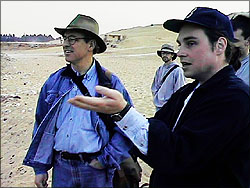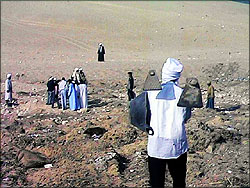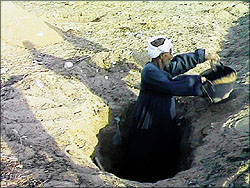
|
Newsflash
January 28, 1997
By John Nolan
 After arriving in Cairo one-by-one, the team members of the Koch-Ludwig Giza
Plateau Mapping Project have finally begun work preparing the excavation site
and their storeroom for the upcoming season. Having received the required
clearances from the Supreme Council of Antiquities (the branch of the
Egyptian Government which oversees all archaeological projects and sites) and
having also met with Dr. Zahi Hawass, the Chief Inspector for Giza and Saqqara, Dr.
Mark Lehner and John Nolan visited the location of previous seasons'
excavations.
After arriving in Cairo one-by-one, the team members of the Koch-Ludwig Giza
Plateau Mapping Project have finally begun work preparing the excavation site
and their storeroom for the upcoming season. Having received the required
clearances from the Supreme Council of Antiquities (the branch of the
Egyptian Government which oversees all archaeological projects and sites) and
having also met with Dr. Zahi Hawass, the Chief Inspector for Giza and Saqqara, Dr.
Mark Lehner and John Nolan visited the location of previous seasons'
excavations.
This field work had uncovered bakeries used in the Old Kingdom
to produce massive amounts of bread for the workmen constructing the pyramids
and tombs at Giza. Also, recently discovered near these bakeries, apparently
contained by a meter and a half thick mudbrick wall was a fish processing
plant, featuring long, low benches, plastered with white limestone dust, and
floors covered with the bones and scales of fish. The goal of the upcoming
field season is to follow the mudbrick retaining wall to the west in hopes of
determining the nature of the large building.
 The first order of business was to hire workmen. After receiving permission
to begin work, word was sent to Abdul Wahab, the foreman (or, in Egyptian
Arabic, "rais," which is pronounced "RAH-ees") who had worked with the team
in previous seasons. It is his responsibility to gather men who are willing
to work, negotiate their wages and act as an intermediary between the team
members and the workmen during the excavation. Two days later, Rais Abdul
Wahab had appeared at the storeroom with a crew of between 20 and 30 men.
The first order of business was to hire workmen. After receiving permission
to begin work, word was sent to Abdul Wahab, the foreman (or, in Egyptian
Arabic, "rais," which is pronounced "RAH-ees") who had worked with the team
in previous seasons. It is his responsibility to gather men who are willing
to work, negotiate their wages and act as an intermediary between the team
members and the workmen during the excavation. Two days later, Rais Abdul
Wahab had appeared at the storeroom with a crew of between 20 and 30 men.
Before we can begin excavation, we had to organize and clean the storeroom
assigned to the project by the Supreme Council of Antiquities. This
storeroom will not only house the finds from previous seasons, but will also
be the place where all material to be excavated in the coming weeks will be
processed. The work of sorting through this material, comprising broken
pieces of pottery, stone tools, inscribed sealing mud, bones and seeds, is an
important part of archaeology. In a sense, the stories these pieces of
evidence tell us will help to reveal how our ancient building was used.
 After the area in front of the storeroom was cleared of debris, a grid of
bricks was laid out on several mats on the top of a nearby tomb. This
checkerboard grid is used by the team members to sort the pottery from the
site according to size, shape and function. Soon after this grid was set
out, team members Jason Ur, Justine Way, and Thomas Kittredge began by
sorting ceramic "sherds" (the term for pieces of broken pottery) from
previous seasons to practice for the new material from the excavation.
After the area in front of the storeroom was cleared of debris, a grid of
bricks was laid out on several mats on the top of a nearby tomb. This
checkerboard grid is used by the team members to sort the pottery from the
site according to size, shape and function. Soon after this grid was set
out, team members Jason Ur, Justine Way, and Thomas Kittredge began by
sorting ceramic "sherds" (the term for pieces of broken pottery) from
previous seasons to practice for the new material from the excavation.
 While the storeroom was being put in order, Rais Abdul Wahab and his crew of
men had moved the kilometer or so down the plateau to the excavation area.
In the more than two years since the previous field season, much sand and
debris had accumulated on top of the bakeries and the fish processing plant.
Also, after each season, the Giza Plateau Mapping Project had covered over
the site with sand to hide and protect it. Both these factors make locating
the site initially difficult. Although during excavation the "squares" used
by the archaeologists are defined by carefully positioned iron stakes,
locating these pins later, under mounds of modern sand, is often a guessing
game. Under the direction of Dr. Lehner, several test pits were sunk in the
sand to try to find these old metal pins. After two days of searching, one,
whose old, tattered label was still intact, was found. Using the coordinates
of this stake, the rest of the excavation area was defined.
While the storeroom was being put in order, Rais Abdul Wahab and his crew of
men had moved the kilometer or so down the plateau to the excavation area.
In the more than two years since the previous field season, much sand and
debris had accumulated on top of the bakeries and the fish processing plant.
Also, after each season, the Giza Plateau Mapping Project had covered over
the site with sand to hide and protect it. Both these factors make locating
the site initially difficult. Although during excavation the "squares" used
by the archaeologists are defined by carefully positioned iron stakes,
locating these pins later, under mounds of modern sand, is often a guessing
game. Under the direction of Dr. Lehner, several test pits were sunk in the
sand to try to find these old metal pins. After two days of searching, one,
whose old, tattered label was still intact, was found. Using the coordinates
of this stake, the rest of the excavation area was defined.
Now, realizing where our food processing building lays, we are clearing away
the modern debris, and should be able to begin digging in a few days.
(table of contents)
Photos: Carl Andrews
Pyramids Home | Pyramids | Excavation
Contents | Mail
|